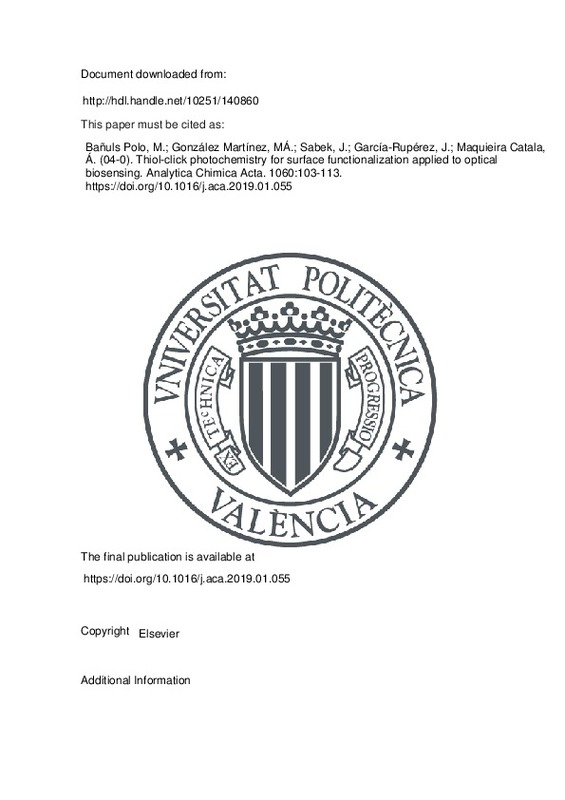|
Resumen:
|
[EN] In the field of biosensing, suitable procedures for efficient probes immobilization are of outmost importance. Here we present different light-based strategies to promote the covalent attachment of thiolated capture ...[+]
[EN] In the field of biosensing, suitable procedures for efficient probes immobilization are of outmost importance. Here we present different light-based strategies to promote the covalent attachment of thiolated capture probes (oligonucleotides and proteins) on different materials and working formats. One strategy employs epoxylated surfaces and uses the light to accomplish the ring opening by a thiol moiety present in a probe. However, most of this work lies on the use of thiol-ene photocoupling chemistry to covalently attach probes to the supports. And thus, both alkenyl and thiol derivatized surfaces are assayed to immobilize thiol or alkene ended probes, respectively, and their performances are compared. Also, the effect of the number of thiols carried by the probe is analyzed comparing single-point and multi-point attachment. The performance of the analogous tethering, but onto alkynylated surfaces is also carried out, and the sensing response is related to the surfaces hydrophobicity. A newly developed reaction is also discussed where a fluorinated surface undergoes the covalent immobilization of thiolated probes activated by light, creating small hydrophilic areas where the probes are attached, and leaving the rest of the surface highly hydrophobic and repellent against protein unspecific adsorption. These mixed surfaces confine the sample (aqueous) uniquely on the hydrophilic spots lowering the background signal and thus increasing the sensitivity. These probe immobilization approaches are applied to fluorescence microarray and label-free nanophotonic biosensing. All the exposed reactions have in common the photoactivation of the thiol moieties, and give rise to quick, clean, versatile, orthogonal and biocompatible reactions. Water is the only solvent used, and light the only catalyzer applied. Thus, all of them can be considered as having the attributes of click-chemistry reactions. For these reasons we named them as thiol-click photochemistry, being a very interesting pool of possibilities when building a biosensor.
[-]
|
|
Agradecimientos:
|
This work was supported by the European Union program Horizon 2020, projects H2020-PHC-634013 and H2020-ICT-644242, and by the Spanish Ministry of Economy and Competitiveness, project CTQ2016-75749-R. Authors thank the ...[+]
This work was supported by the European Union program Horizon 2020, projects H2020-PHC-634013 and H2020-ICT-644242, and by the Spanish Ministry of Economy and Competitiveness, project CTQ2016-75749-R. Authors thank the whole "Signal and Measurement" research group, from the IDM, UPV, for sharing space, research and life. Special thanks to Pilar Jimenez-Meneses, Rafael Alonso, Daniel Gonzalez-Lucas, Pilar Aragon and Patricia Noguera for their contribution to the development of thiol photoattaching chemistry and surface wettability modulation.
[-]
|







![[Cerrado]](/themes/UPV/images/candado.png)


